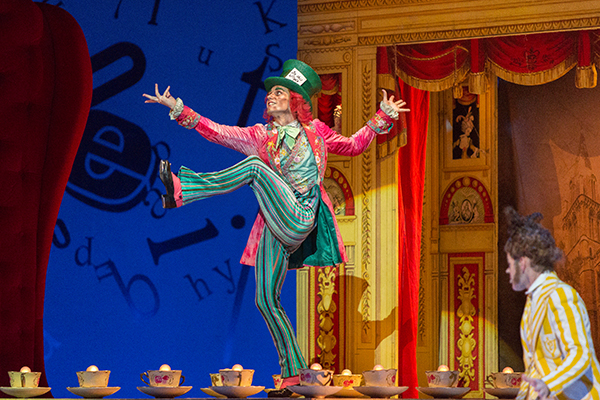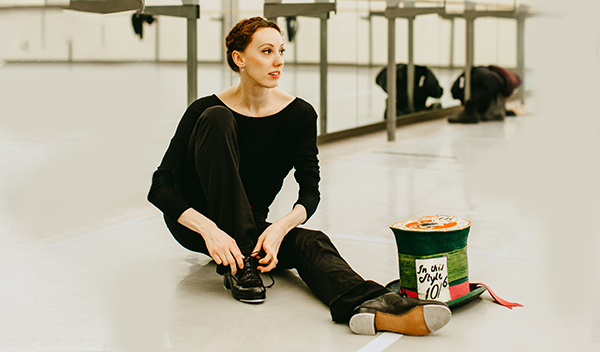Ballet
News+
Stepping Beyond Ballet
by Taylor Long
March 6, 2019

An unusual story makes for an unusual ballet. First premiering in February 2011, Alice’s Adventures in Wonderland is brought to vivid theatrical life by choreographer Christopher Wheeldon and his creative team. The curious tale famously introduced to us by Lewis Carroll in his 1865 novel, is re-imagined for the stage in Wheeldon’s ballet, with various styles of dance intersecting to convey the indescribable world of Wonderland.
A whimsical, theatrical realm materializes before our eyes, with each element, including Joby Talbot’s lush score and Bob Crowley’s larger-than-life set and costume designs, coming together. Projections, robotic moving doors and giant cupcakes provide the foundation for the fantastical staging that pulls Alice through each chapter of her journey.
Wheeldon, who grew up listening to a recording of Alice’s Adventures in Wonderland, stated in an interview with The Daily Telegraph that his inspiration for the piece came from “the vividness of the book’s characters, and the way they all lend themselves to being communicated through movement.”
Although the ballet is predominantly built around Wheeldon’s signature neo-classical style, he has also integrated other styles of dance to bring Alice’s world to life. Describing the genesis of the piece, Wheeldon mentions that he began, “exploring the abstract,” when developing the choreography. In this case, the abstract place steps beyond Classical Ballet, and its many variations, to a plane of different styles, including tap dancing.
“He’s giving you a ballet vocabulary with so many different flavours,” says Second Soloist Donald Thom, one of the dancers taking on the role of the Mad Hatter. Wheeldon has a special task for the Hatter in this ballet – they have to tap.
Thom, who will be making his company debut, performed the role over seven years ago with The Royal Ballet, learning from Principal Dancer Steven McRae, who created the role. He describes tapping as feeling, “totally different,” compared to dancing ballet choreography. “In classical ballet you let the music lead you and tell you what to do – in tapping you become part of the music.”
Switching between the two styles isn’t easy. Wheeldon’s neo-classical choreography demands a certain physicality from its dancers – beautifully articulated feet, good turnout and a lifted upright frame. Tap on the other hand, is very grounded with relaxed knees and ankles turned ‘parallel’.

“Most of the time I’m wearing pointe shoes which require very strong ankles,” says First Soloist Chelsy Meiss, “then I have to change into my tap shoes which require my ankles to be as loose as possible.” Meiss is making a groundbreaking role debut as the Mad Hatter – she will be the very first female dancer to perform the role. “It’s an honour,” says Meiss, “to be able to show this unique aspect of my dancing that otherwise would have remained hidden.”
Meiss grew up tapping, beginning her training at the age of three, before turning her focus to ballet at the age of 15. “Juggling both styles of dance has been tricky,” Meiss says, adding that although the two styles are significantly different, tapping has made her, “a much more musical ballerina.”
But why does the Mad Hatter tap in this ballet? Both dancers point to aspects of Joby Talbot’s cinematic score and the overall commanding presence of the Hatter. Tap gives this character a unique physical language, allowing them to stand out from the others. The distinct style also gives the character another layer of depth by allowing the Hatter the opportunity to make sound, which adds to his/her eccentric qualities.
Within its quirky mix of styles, Alice’s Adventures in Wonderland also references a few iconic ballet moments. A nod to Balanchine’s Apollo shows up in the Mad Hatter’s Tea Party and the famous Rose Adagio sequence from The Sleeping Beauty, inspires the hilarious Tart Adagio performed by the Queen of Hearts.
When asked what she thinks the audience will take away from this melding of styles, Meiss says, “I hope they come away from the performance knowing that all kinds of dance have the ability to speak to people.” Thom adds, “I don’t know how you can’t leave this production without a smile.”
Alice's Adventures in Wonderland is onstage March 7 – 17, 2019.